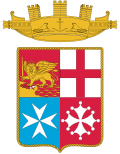 | |
| Class overview | |
|---|---|
| Name | Porto class |
| Builders | Cantiere Navale Giacalone (Napoli) [1] and Cantiere Navale De Poli Pellestrina (Venezia) |
| Operators | |
| Planned | 9 |
| Completed | 9 |
| Active | 9 |
| General characteristics | |
| Type | Coastal tugboat |
| Displacement | 412 t (405 long tons) full load |
| Length | 32.4 m (106 ft 4 in) LOA |
| Beam | 8.5 m (27 ft 11 in) |
| Draught | 3.3 m (10 ft 10 in) |
| Propulsion |
|
| Speed | 11.5 knots (21.3 km/h; 13.2 mph) |
| Range | 1,800 nautical miles (3,300 km; 2,100 mi) at 11.5 knots (21.3 km/h; 13.2 mph) |
| Complement | 12 |
| Sensors & processing systems | 2 x navigation radar GEM Elettronica SPN-748 |
| Notes | can be fitted with echo-sounder Honeywell-Elac Nautik LAZ-50 |
The Porto class of coastal tugboats consists of nine units operated by the Marina Militare Italiana, named as Rimorchiatore Costiero. [2]
